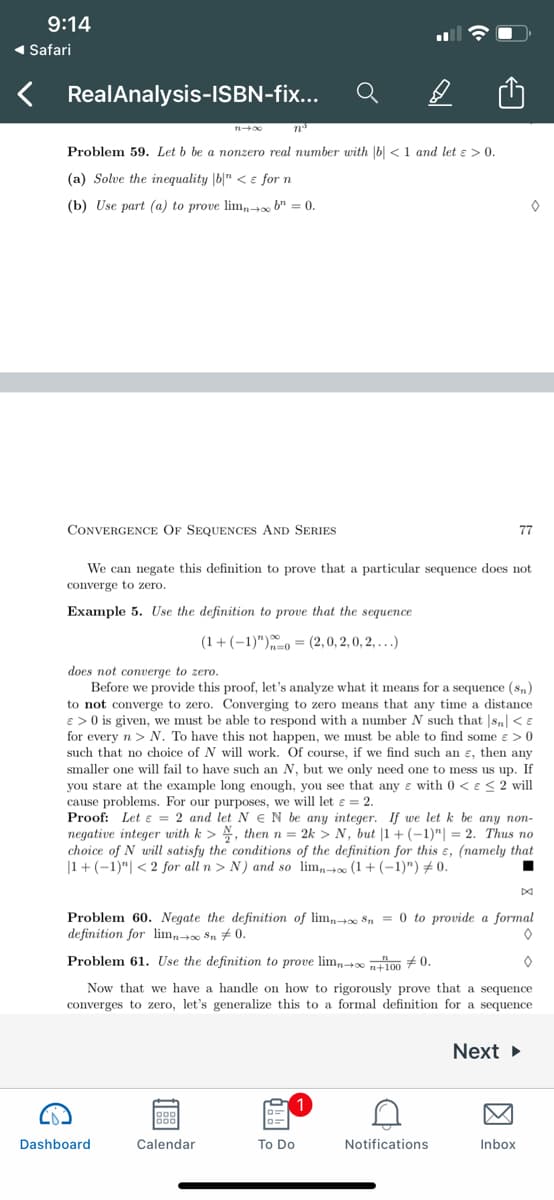Problem 61. Use the definition to prove lim,-o n100 # 0. n+100
Algebra & Trigonometry with Analytic Geometry
13th Edition
ISBN:9781133382119
Author:Swokowski
Publisher:Swokowski
Chapter10: Sequences, Series, And Probability
Section: Chapter Questions
Problem 63RE
Related questions
Question
100%
#61

Transcribed Image Text:9:14
1 Safari
RealAnalysis-ISBN-fix..
Problem 59. Let b be a nonzero real number with |b| < 1 and let ɛ > 0.
(a) Solve the inequality |b|" < e for n
(b) Use part (a) to prove lim,t b" = 0.
CONVERGENCE OF SEQUENCES AND SERIES
77
We can negate this definition to prove that a particular sequence does not
converge to zero.
Example 5. Use the definition to prove that the sequence
(1+(-1)")0 = (2,0, 2, 0, 2, .)
does not converge to zero.
Before we provide this proof, let's analyze what it means for a sequence (sn)
to not converge to zero. Converging to zero means that any time a distance
e >0 is given, we must be able to respond with a number N such that |s,| < E
for every n > N. To have this not happen, we must be able to find some e >0
such that no choice of N will work. Of course, if we find such an ɛ, then any
smaller one will fail to have such an N, but we only need one to mess us up. If
you stare at the example long enough, you see that any e with 0 < e< 2 will
cause problems. For our purposes, we will let e = 2.
Proof: Let e = 2 and let N EN be any integer. If we let k be any non-
negative integer with k > , thenn= 2k > N, but |1 + (–1)"| = 2. Thus no
choice of N will satisfy the conditions of the definition for this ɛ, (namely that
|1+ (-1)"| < 2 for all n > N) and so lim,0 (1+ (-1)") #0.
Problem 60. Negate the definition of lim, $n = 0 to provide a formal
definition for lim,+ Sn # 0.
Problem 61. Use the definition to prove lim 0 100 #0.
Now that we have a handle on how to rigorously prove that a sequence
converges to zero, let's generalize this to a formal definition for a sequence
Next
Dashboard
Calendar
To Do
Notifications
Inbox
Expert Solution
This question has been solved!
Explore an expertly crafted, step-by-step solution for a thorough understanding of key concepts.
Step by step
Solved in 2 steps

Recommended textbooks for you

Algebra & Trigonometry with Analytic Geometry
Algebra
ISBN:
9781133382119
Author:
Swokowski
Publisher:
Cengage

Algebra & Trigonometry with Analytic Geometry
Algebra
ISBN:
9781133382119
Author:
Swokowski
Publisher:
Cengage